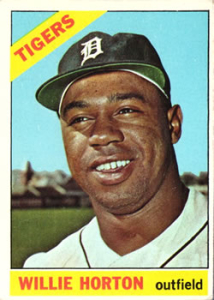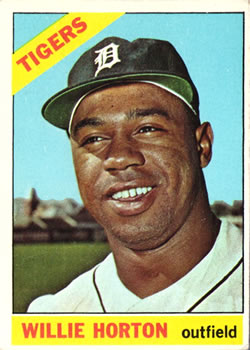August 8, 1967: Tigers return to the Corner after 1967 race riot
In the early morning hours of Sunday, July 23, 1967, Detroit police raided an after-hours “blind pig,” an unlicensed bar, at 12th Street and Clairmount Avenue in the center of the city’s oldest and poorest black neighborhood.1 A party at the bar was in progress to celebrate the return of two African-American servicemen from Vietnam. After the arrest of more than 80 partygoers, and accusations of police brutality, violence erupted. Within hours the situation deteriorated into a full-fledged riot, prompting Detroit Mayor Jerome Cavanaugh to request that the National Guard be sent in to stop the violence.
poorest black neighborhood.1 A party at the bar was in progress to celebrate the return of two African-American servicemen from Vietnam. After the arrest of more than 80 partygoers, and accusations of police brutality, violence erupted. Within hours the situation deteriorated into a full-fledged riot, prompting Detroit Mayor Jerome Cavanaugh to request that the National Guard be sent in to stop the violence.
That afternoon, 3½ miles to the south, the Detroit Tigers, who were locked in a five-team pennant race, were taking on the New York Yankees in a doubleheader. As the afternoon progressed, thick, black clouds of smoke billowing above the left-field grandstand were the first signs of trouble for the players, fans, and workers at the ballpark.
After the Tigers and Yankees split the twin bill, many players quickly left the ballpark without showering. Left fielder Willie Horton, who had hit his 13th home run of the year, didn’t even remove his uniform. Horton recalled the day: “I jumped in my car, I drove over by 12th Street near the blocks where I had delivered Michigan Chronicle newspapers as a child. … It looked like a war zone. … I exited my car, climbed on the roof and started shouting at people until I got their attention. … ‘Why are you burning up and tearing up the neighborhood you live in?’” I asked. “I kept asking why are you doing this, but no one had an answer.”2
As the rioting continued for five days and nights, the American League quickly adjusted its schedule and sent the homestanding Tigers to Baltimore instead of having the team host the Orioles for a midweek three-game series. When the violence finally subsided, 43 people had been killed, 1,189 injured, 7,231 arrested, 2,509 stores had been looted or burned, 690 buildings were destroyed, and 388 families were displaced.3 Until the riots after the assassination of Dr. Martin Luther King in April 1968, the Detroit Race Riot stood as the largest urban uprising of the 1960s.4
Eleven days after the end of the rioting, a crowd of 44,295, the fifth largest crowd of the season, came out to the ballpark at Michigan and Trumbull for Shriner Night and a twilight doubleheader. The third-place Tigers (57-49), who were tied with the Minnesota Twins, hosted the first-place Chicago White Sox (59-45), who held a 2½-game lead over the second-place Boston Red Sox. The games marked the Tigers’ first appearance in Detroit since the end of the rioting on July 28.
In the opener, White Sox left-hander Gary Peters opposed the Tigers’ Denny McLain. Peters entered the game with a record of 12-6 and a 2.30 ERA. The right-handed McLain, winner of three of his last four starts, was 13-12 with a 3.53 ERA.
The temperature was 83 degrees, skies were partly cloudy, and the wind was blowing in from left field at 9 mph when McLain set the White Sox down in order in the top of the first. The Tigers threatened in their half of the first when third baseman Don Wert led off with a double. Al Kaline drew a one-out walk before Peters struck out Horton and retired Bill Freehan on a groundout to second to end the inning.
Left fielder Pete Ward put the White Sox ahead when he led off the second inning with a high fly ball that caught the overhang of the upper deck in right. It was Ward’s 10th home run of the season. McLain retired the next three batters and at the end of an inning-and-a-half, the White Sox led 1-0.
From there, Peters and McLain became locked in a pitchers’ duel. After the walk to Kaline in the first, Peters retired nine consecutive Tigers before Horton reached on a throwing error by third baseman Don Buford in the bottom of the fourth. The only other baserunner to reach off Peters during the first five innings was Mickey Stanley, who singled to lead off the fifth but was erased when McLain hit into a one-out double play to end the inning. McLain was equally as effective, scattering three hits and one walk over the final eight innings.
The Tigers tied the game in the bottom of the sixth when Kaline hit a two-out solo home run off Peters. The home run, Kaline’s 18th of the season, was a liner off the facing of the upper deck in left-center.
Peters ran into trouble in the bottom of the eighth inning. With one out, Wert reached on a single to shortstop. Second baseman Dick McAuliffe followed with a walk that moved Wert into scoring position. This prompted White Sox manager Eddie Stanky to call on right-handed knuckleballer Hoyt Wilhelm to quell the Tiger uprising. Wilhelm entered the game with a record of 6-1, 10 saves, and a 1.26 ERA. On cue, the White Sox relief ace struck out Kaline and induced Horton to ground into an unassisted force at third to keep the score tied, 1-1.
The game remained tied until the bottom of the 10th. McLain, who was 0-for-3 and hitting only .095, legged out an infield single. Wert put down a sacrifice bunt to Buford, who made a questionable, throw to first when it looked as though he had a chance to get McLain at second. After the game McLain confided to reporters that he thought Buford had a play on him at second. “Frankly, I was surprised when he threw over to first,” McLain said.5
McAuliffe followed with a walk and Kaline appeared to win the game with a hit to left-center. However Ken Berry, who came on as a defensive replacement for Ward to start the bottom of the inning, made “a great throw” to cut down McLain at the plate.6 Kaline and McAuliffe advanced to second and third respectively.
That brought Horton to the plate. Sixteen days earlier, when the civil unrest broke out, the native of Detroit rushed to the epicenter of the riot in an effort to quell the rioters.7 Today he had the opportunity to help heal the city by driving in the winning run of the first game back.
Horton didn’t get a chance to swing the bat and in an instant the great game-saving throw made by Berry was forgotten. The first pitch to Horton was “a darting knuckler that slid off the glove of J.C. Martin, enabling McAuliffe to race home with the winning run.”8 The Tigers “exploded onto the field as if they were shot out of a cannon” and mobbed McAuliffe as he headed back to the home dugout along the third-base line.9
After the game Tigers manager Mayo Smith remarked, “The only way you can beat (Wilhelm) is to get a runner over to third and hope.”10 Detroit Free Press sports editor Joe Falls deflected blame away from Martin when he compared the difficulty of catching Wilhelm to “trying to swat a mosquito in a dark room.”11
With the win, the Tigers moved to within two games of the White Sox. McLain earned the victory with his ninth complete game of the season and improved to 14-12. Wilhelm (6-2) suffered the loss, his first since June 2. The time of the game was 2 hours and 53 minutes.
In the nightcap, Tommy McCraw hit a pair of home runs and the White Sox rallied from a 4-2 deficit in the eighth inning to beat the Tigers 6-4 in another 10-inning affair. The loss, coupled with a Twins victory, dropped Detroit to fourth place. The White Sox maintained their 2½-game advantage when the Red Sox split a doubleheader with the Kansas City Athletics.
The Tigers remained in the pennant race until the very end and finished tied with the Minnesota Twins for second place, a single game behind the American League champion Boston Red Sox. The city ripped apart by the midsummer violence would have to wait another year to see the Tigers return to the World Series for the first time in 23 years.
Sources
In addition to the sources cited in the Notes, the author consulted Baseball-Reference.com and Retrosheet.org.
Notes
1 Tabitha Wang, “Detroit Race Riot (1967),” https://blackpast.org/african-american-history/detroit-race-riot-1967/.
2 Bill Dow, “Detroit ’67: As Violence Unfolded, the Tigers Played Two at Home vs. Yankees,” Detroit Free Press, July 23, 2017. https://freep.com/story/sports/mlb/tigers/2017/07/23/detroit-tigers-1967-riot-new-york-yankees/499951001/.
3 Dow.
4 Wang.
5 Joe Falls, “The Big Play? Errant Knuckler,” Detroit Free Press, August 9, 1967: 25.
6 Falls.
7 Rhiannon Walker, “Detroit Tiger Willie Horton Tried to Bring Peace During the 1967 Riots,” The Undefeated, https://theundefeated.com/features/detroit-tiger-willie-horton-peace-during-1967-riots/.
8 Edward Prell, “Sox Rally to Gain Split with Tigers,” Chicago Tribune, August 9, 1967: 65.
9 Falls.
10 Falls.
11 Falls.
Additional Stats
Detroit Tigers 2
Chicago White Sox 1
Game 1, DH
Tiger Stadium
Detroit, MI
Box Score + PBP:
Corrections? Additions?
If you can help us improve this game story, contact us.


